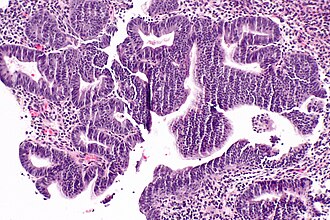Difference between revisions of "Complex endometrial hyperplasia"
Jump to navigation
Jump to search
(+infobox) |
|||
| Line 120: | Line 120: | ||
==See also== | ==See also== | ||
*[[Endometrial hyperplasia]]. | *[[Endometrial hyperplasia]]. | ||
*[[Endometrial carcinoma]]. | |||
*[[Gynecologic pathology]]. | |||
==References== | ==References== | ||
Revision as of 02:56, 20 December 2013
| Complex endometrial hyperplasia | |
|---|---|
| Diagnosis in short | |
 Complex endometrial hyperplasia. H&E stain. | |
| Site | endometrium - see endometrial hyperplasia |
|
| |
| Associated Dx | obesity |
| Clinical history | usu. premenopausal or perimenopausal |
| Symptoms | abnormal uterine bleeding (AUB) |
| Prevalence | common |
| Clin. DDx | dysfunctional uterine bleeding (diagnosis of exclusion), endometrial carcinoma, atrophy |
| Complex endometrial hyperplasia | |
|---|---|
| External resources | |
| EHVSC | 10169 |
Complex endometrial hyperplasia, abbreviated CEH, is a relatively common pre-malignant pathology of the endometrium.
It is generally subdivided into complex endometrial hyperplasia without atypia and complex endometrial hyperplasia with atypia.
Microscopic
Features:
- Increase in size & number of glands + irregular shape - key feature.
- Cell stratification.
- Nuclear enlargement.
- Mitoses common.
- No nuclear atypia.
Notes:
- Normal "gland-to-stroma ratio" is 1:3.
- Two "touching" glands may be one gland in section.
DDx:
- Complex endometrial hyperplasia with atypia.
- Endometrioid endometrial carcinoma - see endometrial carcinoma versus complex endometrial hyperplasia.
Endometrial carcinoma versus complex endometrial hyperplasia
Complex endometrial hyperplasia:
- Non-confluent - glands distinct from one another.
Classic criteria for endometrial carcinoma
This is pimping material that shows up on exams.
Endometrial carcinoma has one of the following:[1][2][3]
- Desmoplastic stromal response.
- Confluent cribriform growth. †
- Extensive papillary growth. †
- Severe cytologic atypia. †
Note:
- † There is a size cut-off for criteria 2, 3 and 4: > 2.1 mm.[2]
How to remember ABCDE:
- Atypia Bad.
- Confluent cribriform growth.
- Desmoplasia.
- Extensive papillary growth.
Images
Complex endometrial hyperplasia:
Squamous morules - commonly associated with hyperplasia and malignancy:
Fused glands suggestive of CEH in a polyp:
www:
Sign out
ENDOMETRIUM, BIOPSY: - COMPLEX ENDOMETRIAL HYPERPLASIA. -- NEGATIVE FOR CYTOLOGIC ATYPIA.
ENDOMETRIUM, BIOPSY: - SMALL FOCUS OF COMPLEX ENDOMETRIAL HYPERPLASIA WITHOUT ATYPIA, WITH SQUAMOUS MORULES. - ENDOMETRIAL POLYP WITH ONE ATYPICAL GLAND AND A SQUAMOUS MORULE. - SCANT ENDOCERVICAL EPITHELIUM WITHOUT APPARENT PATHOLOGY.
See also
References
- ↑ Nucci, Marisa R.; Oliva, Esther (2009). Gynecologic Pathology: A Volume in Foundations in Diagnostic Pathology Series (1st ed.). Churchill Livingstone. pp. 239. ISBN 978-0443069208.
- ↑ 2.0 2.1 Kurman, RJ.; Norris, HJ. (Jun 1982). "Evaluation of criteria for distinguishing atypical endometrial hyperplasia from well-differentiated carcinoma.". Cancer 49 (12): 2547-59. PMID 7074572.
- ↑ URL: http://www.cap.org/apps/docs/committees/cancer/cancer_protocols/2011/Endometrium_11protocol.pdf. Accessed on: 12 January 2012.








